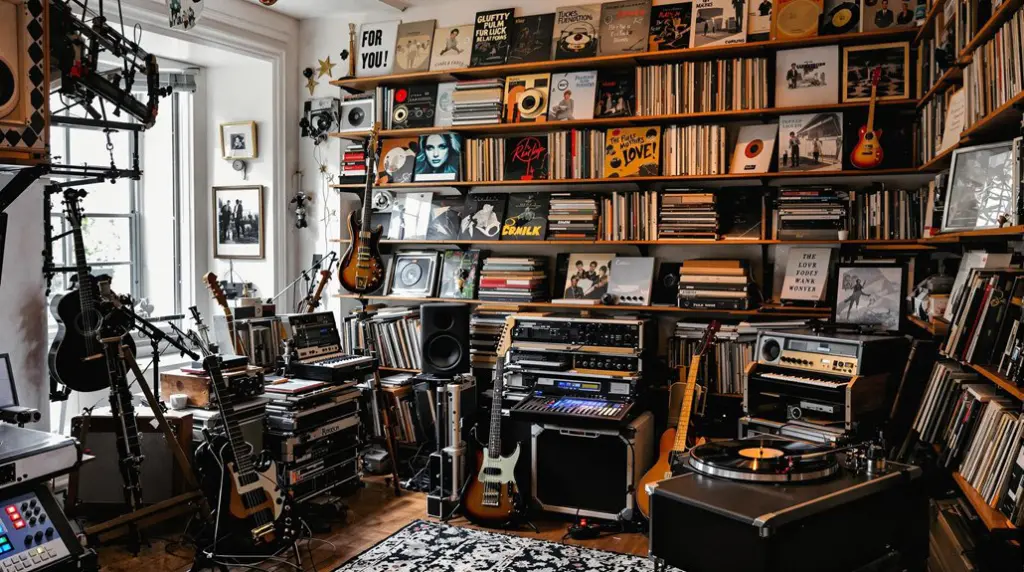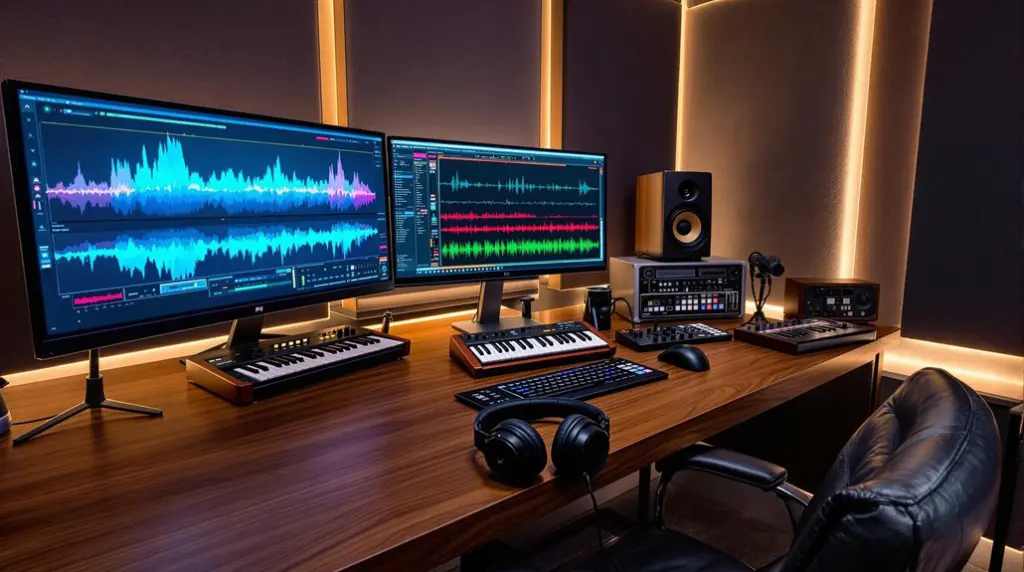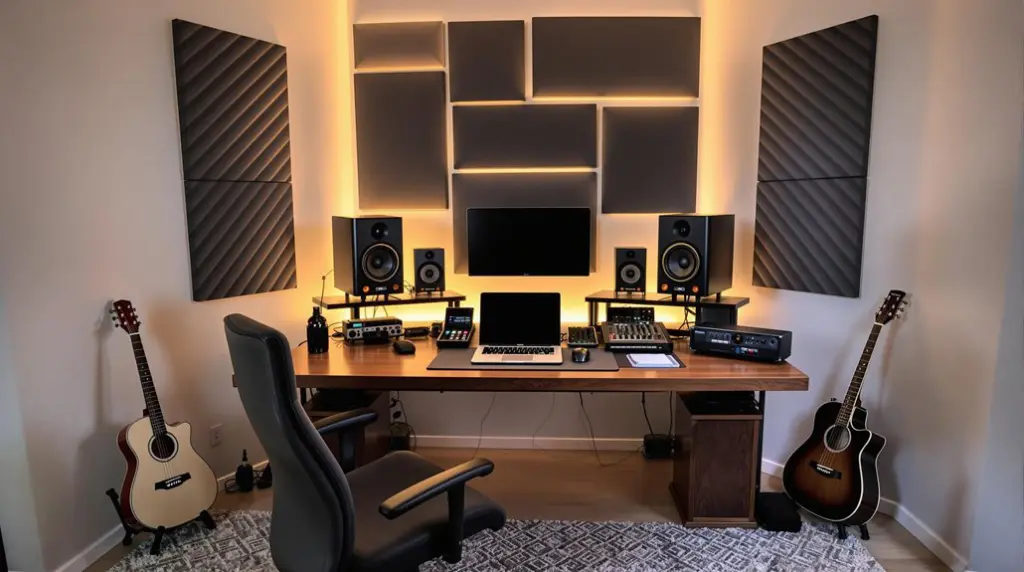A dynamic EQ operates by automatically adjusting the gain of specific frequency bands based on the incoming audio signal’s amplitude. When the signal exceeds a set threshold, it engages, allowing nuanced control over problematic frequencies. Unlike static EQ, a dynamic EQ reacts in real time, preserving the natural dynamics of a mix while addressing harsh resonances and frequency masking. You can customize parameters such as frequency, Q, and slope to tailor its response to your needs. Understanding the intricacies of this tool can greatly enhance your mixing and mastering capabilities. There’s much more to explore about its applications and best practices.
Key Takeaways
- A dynamic EQ adjusts frequency content based on the amplitude of the incoming audio signal, engaging only when the signal exceeds a set threshold.
- It combines traditional equalization with dynamic control, allowing for real-time adjustments to targeted frequency bands.
- The tool utilizes customizable parameters like frequency, Q, and slope to tailor its response for specific audio needs.
- Dynamic EQ helps manage unwanted peaks and prevent frequency masking, preserving the integrity and clarity of the audio mix.
- It operates similarly to compressors, dynamically shaping the sound while maintaining the natural dynamics of the performance.
Definition of Dynamic EQ
Dynamic EQ is an advanced audio processing tool that merges traditional equalization with dynamic control to enhance sound quality.
It intelligently adjusts frequency content based on the amplitude of the incoming signal, allowing you to boost or cut specific frequency bands dynamically. By setting a threshold, dynamic EQ engages only when the signal exceeds this level, providing precise dynamics processing without permanently altering your sound.
This flexibility is vital for managing problem frequencies in vocals and instruments, as it adapts in real-time. Utilizing bell and shelf filters, dynamic EQ effectively controls resonances, offering a tailored approach that static EQ can’t achieve. This makes it an essential tool for achieving clarity and balance in your audio mix, especially as it provides surgical control over frequency adjustments that enhance the overall mix quality.
How Dynamic EQ Functions
Dynamic EQ operates through responding to signal levels, adjusting gain based on a set threshold. This interaction allows you to control specific frequency bands dynamically, effectively managing unwanted peaks while enhancing desired elements in your mix. Additionally, multiband compression can be used in conjunction with dynamic EQ to target and balance specific frequency ranges more precisely.
Signal Level Interaction
While working with audio processing, understanding how signal level interaction influences EQ adjustments is essential.
Dynamic EQ operates by responding to the incoming signal intensity at specific frequencies, effectively altering gain values to manage frequency content. When the signal exceeds a defined threshold, the dynamic EQ engages, enabling targeted equalization that either boosts or cuts frequencies as needed.
Unlike traditional EQ, the gain changes in dynamic EQ aren’t static; they adapt in real-time, similar to a compressor or expander, ensuring a natural sound.
With adjustable parameters like frequency, Q, and slope, dynamic EQ provides customized responses to audio dynamics, making it particularly effective for mitigating resonances and addressing frequency masking in your mixes.
Threshold and Gain Dynamics
Understanding how threshold and gain dynamics function is vital for effectively utilizing dynamic EQ in audio processing. The threshold determines when the EQ activates, engaging only when the signal surpasses a set dB level.
Gain adjustments are essential in this process:
- Positive Gain Adjustments: These boost frequencies when levels are low, akin to expansion.
- Negative Gain Adjustments: These reduce frequencies above the threshold, similar to compression.
- Attack and Release Times: Fine-tuning these settings allows you to control how quickly the EQ reacts to signal changes.
- Frequency Bands: Targeting specific bands guarantees precise adjustments tailored to dynamic audio.
This flexibility enables real-time response to frequency issues, providing transparent processing that adapts to performance dynamics.
Frequency Band Control
Frequency band control in dynamic EQ allows for precise adjustments to specific frequency ranges based on the audio signal’s intensity. By configuring parameters such as frequency, gain, Q (bandwidth), and a threshold level, you gain the flexibility to manage each frequency band effectively.
When the audio signal exceeds the threshold, the dynamic EQ can act like a compressor, attenuating resonances, or like an expander, boosting frequencies as needed. This responsive control means you can adaptively address harsh frequencies that fluctuate during a performance.
Unlike static EQ, dynamic EQ provides real-time frequency shaping, enhancing clarity and ensuring a polished mix. Ultimately, dynamic EQ empowers you to maintain tonal balance amidst complex audio sources.
Key Features of Dynamic EQ
Dynamic EQs are powerful tools that integrate traditional equalization with advanced processing capabilities, making them essential for precise audio mixing.
Here are some key features that enhance their functionality:
- Threshold Control: Activates frequency adjustments based on incoming audio signal levels.
- Adjustable Gain: Responds to signal intensity, similar to compressors, allowing dynamic frequency shaping.
- Multiple Filter Bands: Many dynamic EQ plugins, like the F6 Floating-Band Dynamic EQ, offer fully adjustable bands for detailed control over the frequency spectrum.
- Sidechain Input: Enables frequency-specific processing by using external audio signals to address resonances and masking issues effectively.
Additionally, dynamic EQs can help prevent frequency masking, ensuring that individual tracks remain distinct and clear in a mix.
These features collectively enhance your mixing process, providing flexibility and precision in audio production.
Benefits of Using Dynamic EQ
One of the standout advantages of using a dynamic EQ is its ability to provide targeted frequency adjustments that react in real-time to audio signal levels. This feature allows you to gain precise control over the frequency spectrum without adversely affecting the overall mix.
Unlike traditional EQ, which applies static adjustments, a dynamic EQ can automatically boost or cut frequencies only when necessary, preserving the natural dynamics of a performance. This is particularly beneficial in live audio scenarios where room acoustics may amplify problematic resonances.
Furthermore, dynamic EQ enhances clarity and balance in mixing and mastering by enabling subtle adjustments to harsh frequencies, effectively reducing the risk of over-processing and static artifacts commonly associated with traditional EQ. Additionally, dynamic EQ can be particularly effective in addressing frequency conflicts in dense mixes, ensuring that each element occupies its own space in the audio spectrum.
Dynamic EQ vs. Static EQ
When comparing dynamic EQ to static EQ, you’ll notice significant differences in frequency response and processing mechanisms.
Dynamic EQ adapts in real-time to signal changes, making it more effective in managing problematic frequencies without altering the mix’s overall integrity.
In contrast, static EQ applies fixed adjustments, which can lead to unintended consequences, especially in varied use cases.
Frequency Response Differences
While traditional static EQ applies fixed frequency adjustments, dynamic EQ offers a more adaptive approach by modifying its response in real-time based on the incoming audio signal’s intensity. This results in several key advantages:
- Targeted Adjustments: Dynamic EQ selectively boosts or cuts frequencies only when specific thresholds are exceeded, preserving tonal characteristics.
- Real-Time Adaptation: It can manage resonant frequencies as they arise during performances, providing a transparent solution.
- Reduced Artifacts: Unlike static EQ, which may introduce muddiness or harshness, dynamic EQ maintains sound integrity across varying dynamics.
- Efficiency: You won’t need to make multiple adjustments for different levels, as dynamic EQ responds only to problematic frequencies, ensuring a balanced mix.
Adaptive Processing Mechanisms
Dynamic EQ and static EQ represent two fundamentally different approaches to audio processing, each with its own strengths and weaknesses. While static EQ applies fixed adjustments to frequency response, dynamic EQ utilizes adaptive processing to engage only when the audio signal exceeds a defined threshold parameter. This results in targeted, real-time adjustments that maintain sound clarity and prevent unwanted resonance buildup.
| Feature | Dynamic EQ |
|---|---|
| Gain Adjustment | Adaptive based on amplitude |
| Threshold Engagement | Yes |
| Frequency Targeting | Specific problematic frequencies |
| Impact on Mix | Minimal, preserves integrity |
Use Cases Comparison
Although both dynamic and static EQ serve essential roles in audio mixing, their applications vary considerably based on the context of use.
Here’s a comparison of use cases:
- Dynamic EQ is ideal for live performances, managing fluctuating resonant frequencies effectively.
- It selectively targets specific frequencies during louder sections, enhancing clarity without compromising tonal balance.
- For vocal mixing, dynamic EQ allows nuanced adjustments that follow harmonic movement, which static EQ struggles to achieve.
- Static EQ applies uniform adjustments, potentially cutting frequencies that aren’t problematic, risking vocal or instrument performance.
Dynamic EQ and Frequency Management
One key advantage of using dynamic EQ in frequency management is its ability to precisely control specific frequency bands based on the audio signal’s intensity. By setting a threshold, dynamic EQ activates processing only when the signal exceeds a defined level, allowing you to manage resonant frequencies during dynamic performances.
You can employ bell and shelf filters to enhance or attenuate frequencies only when necessary, effectively addressing harshness or muddiness without introducing unwanted artifacts. This real-time responsiveness guarantees transparent tonal shaping, preserving critical frequencies while dynamically controlling problematic resonances. Additionally, dynamic EQ can be particularly beneficial in managing frequency interactions that may arise in complex mixes, ensuring a balanced and polished sound.
Ultimately, dynamic EQ is essential for improving vocal clarity and maintaining instrument separation, making it a powerful tool in complex mixes where precision is paramount.
Practical Applications of Dynamic EQ
When you’re mixing audio, understanding the practical applications of dynamic EQ can greatly improve your workflow and sound quality.
Here are four key areas where you can utilize dynamic EQ effectively:
- Vocal Control: Tame harsh frequencies in vocals, ensuring clarity while preserving their natural dynamics.
- Drum Presence: Enhance the presence of kick and snare drums, managing their fundamental frequencies to sit well in the mix without overpowering other elements.
- Live Sound Management: Use dynamic EQ to address problematic frequencies in live scenarios, providing targeted adjustments based on room acoustics.
- Frequency Ducking: Leverage sidechain inputs to duck specific frequencies, preventing masking among competing instruments, thereby improving overall mix cohesion.
Implementing these strategies will greatly improve your sound quality in mixing. Additionally, understanding frequency response is crucial for making effective dynamic EQ adjustments.
Common Techniques for Dynamic EQ
To effectively tame problematic frequencies, you can leverage dynamic EQ‘s threshold-based adjustments for targeted cuts and boosts.
When enhancing vocal clarity, utilizing sidechain inputs allows your dynamic EQ to respond to competing instruments, creating a cleaner mix.
Incorporating multiband compression can further refine your approach by allowing detailed shaping across different frequency bands.
These techniques guarantee that your audio maintains its integrity while addressing specific frequency concerns.
Taming Problematic Frequencies
How can you effectively manage problematic frequencies in your mix? Taming harsh elements requires precision, and that’s where dynamic EQ offers significant advantages. This tool allows you to target certain frequencies without affecting the entire mix.
Here are some common techniques you can employ:
- Identify Resonances: Use dynamic EQ to spot and manage resonant frequencies in vocals, ensuring clarity without harshness.
- Utilize Sidechain Inputs: Process specific frequencies based on competing instruments’ levels for a more cohesive mix.
- Adjust Bands: Tools like the F6 Floating-Band Dynamic EQ let you finely tune multiple bands to address specific issues.
- Control Transient Peaks: Apply a gentle ratio and adjust attack/release settings to control transient peaks in instruments, maintaining balance.
Enhancing Vocal Clarity
Dynamic EQ is essential for enhancing vocal clarity, particularly when addressing resonant frequencies that can muddy a mix. Focus on the 200-400 Hz range, where these frequencies typically reside.
By utilizing tools like Nectar 3 Plus, you can employ the Follow EQ feature, allowing automatic adjustments to EQ nodes as vocal harmonics shift. This maintains clarity without constant manual tweaking.
Additionally, applying upward expansion with dynamic EQ enhances softer vocal phrases, ensuring they’re heard clearly without overwhelming the mix.
Incorporating sidechain inputs can also help by ducking specific frequencies from competing instruments, preserving vocal prominence.
Finally, leverage real-time frequency spectrum analysis to identify and address problematic frequencies, resulting in clearer, more present vocals.
Dynamic EQ in Vocal Processing
While mixing vocals, utilizing a dynamic EQ can greatly enhance clarity and control over the frequency spectrum. This tool automatically adjusts frequency boosts or cuts based on the vocal performance’s dynamics, ensuring problematic resonant frequencies are tamed only when necessary.
Here are four key benefits of using dynamic EQ in vocal processing:
- Sibilance Management: Effectively targets harsh sibilance without sacrificing warmth.
- Real-Time Adjustments: Features like Follow EQ adapt to changing harmonics for more precise mixing.
- Maintained Clarity: Preserves vocal presence by only affecting frequencies that exceed a threshold.
- Background Vocal Control: Selectively ducks certain frequencies to enhance lead vocal clarity.
Additionally, dynamic range management is crucial in ensuring that vocals sit well within the mix without overpowering other elements.
Dynamic EQ for Instrument Clarity
When you apply dynamic EQ to instrument clarity, you gain a powerful tool that responds to the nuances of each performance. This technique allows for precise frequency adjustments that adapt to varying instrument dynamics, ensuring clarity without overwhelming your mix.
By targeting specific resonance frequencies, dynamic EQ effectively tames harshness, such as the sharpness in electric guitar or brass during intense passages. Utilizing a sidechain trigger, you can unmask overlapping frequencies, enhancing separation within the mix.
The ability to apply compression based on signal strength means softer notes can shine while preventing louder ones from dominating. With real-time adjustments, dynamic EQ maintains the integrity of your instruments’ sounds, offering a transparent solution for dynamic range issues without introducing artifacts. Additionally, mastering dynamic movement effects can further enhance the overall impact of your mix.
Choosing the Right Dynamic EQ Plugin
How do you choose the right dynamic EQ plugin for your mixing needs? Here are key factors to take into account:
- Adjustable Filter Types: Look for options like bell, shelf, or notch filters to tailor your sound precisely.
- Visual Feedback Tools: Opt for plugins with real-time frequency analyzers to easily identify problem areas and monitor adjustments.
- CPU Usage: Evaluate how much processing power the plugin requires. Lightweight options, like TDR Nova, can handle complex tasks without straining your system.
- User Reviews: Check ratings and feedback, such as the F6 Floating-Band Dynamic EQ’s impressive 4.78-star rating from almost 1,000 users, to gauge reliability and real-world effectiveness.
These features will guarantee you select a dynamic EQ that meets your specific mixing requirements. Additionally, consider the plugin’s ability to provide dynamic equalization capabilities, which can enhance your control over problematic frequencies during the mixing process.
Best Practices for Dynamic EQ
To achieve the best results with dynamic EQ, start by applying gentle settings to avoid harshness in your mix. Gradually increase intensity only as needed for subtle adjustments.
Use the real-time frequency spectrum analyzer in your dynamic EQ plugin to visually pinpoint problematic frequencies before making changes. Pay close attention to your threshold settings, ensuring the dynamic EQ activates only when the signal exceeds a specific level, preserving a natural sound during quieter passages.
Experiment with different filter shapes, like bell or shelf, to effectively address specific frequency issues. Regularly bypass the dynamic EQ to compare the processed sound with the original, ensuring your adjustments enhance clarity without compromising overall mix balance.
Resources for Learning Dynamic EQ
Dynamic EQ is a powerful tool in audio production, and various resources can enhance your understanding and application of this technique.
To deepen your knowledge, consider the following:
- eMastered – Access weekly audio production tips from Grammy-winning founders focusing on dynamic EQ techniques.
- Online Courses – Platforms like Coursera and Udemy offer detailed tutorials on dynamic EQ functionality and best practices.
- YouTube Channels – Explore channels dedicated to music production for real-world examples demonstrating dynamic EQ in action.
- Community Forums – Engage with discussions on sites like Gearslutz and KVR Audio to exchange experiences and tips with fellow users.
These resources will provide the insights needed to master dynamic EQ in your music production endeavors.
Frequently Asked Questions
How to Set Dynamic EQ?
To set dynamic EQ, analyze your frequency response, identify problem areas, and adjust dynamic EQ settings. Employ mastering techniques, ensuring precise control over audio mixing while maintaining natural sound dynamics for ideal results in your design.
Should Dynamic EQ Go Before or After Compressor?
In audio mixing, dynamic EQ placement before the compressor optimizes frequency response and enhances compressor interaction. This order maintains signal flow, ensuring problematic frequencies are controlled effectively, leading to a clearer and more balanced mix.
What Is Different About Dynamic EQ?
Dynamic EQ excels in sound shaping by adjusting frequency response based on audio dynamics. Unlike static EQ, it adapts to musical context, enhancing mixing techniques through targeted corrections that respond to varying signal levels without compromising clarity.
What Is the Difference Between Static and Dynamic EQ?
Static EQ advantages lie in its simplicity for broad frequency adjustments, while dynamic EQ applications offer nuanced control in sound design techniques. Mastering tips emphasize frequency response management, ensuring clarity and balance throughout your mix.
Conclusion
Incorporating dynamic EQ into your mixing and mastering processes can greatly enhance your sound. By understanding its functions and key features, you can effectively manage frequency clashes and improve instrument clarity. Remember to choose the right plugin and apply best practices for ideal results. As you experiment with dynamic EQ, you’ll discover its unique advantages over static EQ, ultimately elevating your audio productions. Stay curious and continue exploring the resources available to deepen your knowledge in this powerful tool.




